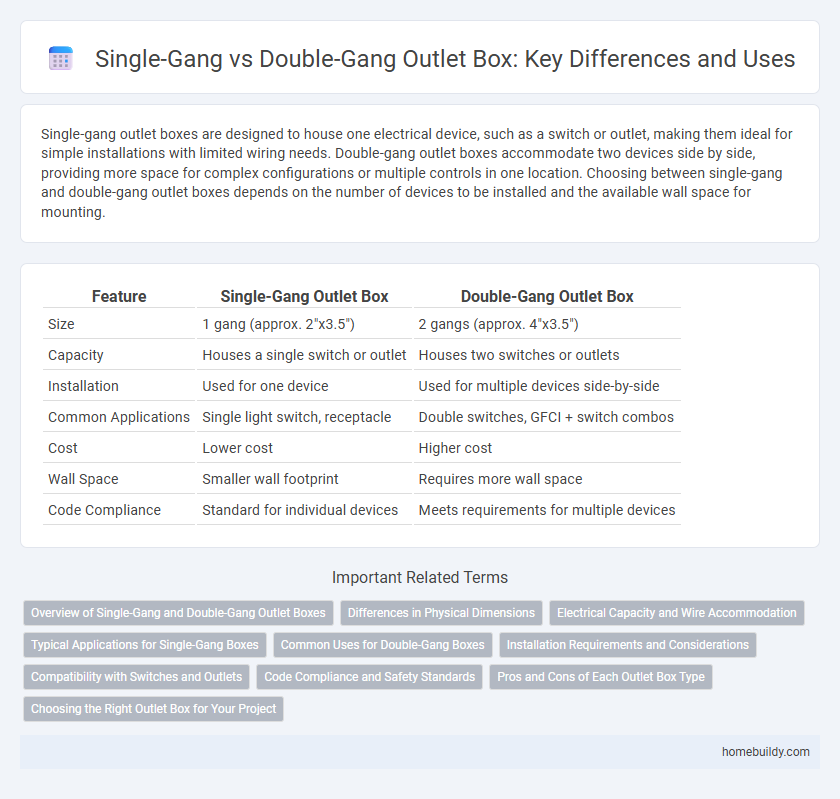Single-gang outlet boxes are designed to house one electrical device, such as a switch or outlet, making them ideal for simple installations with limited wiring needs. Double-gang outlet boxes accommodate two devices side by side, providing more space for complex configurations or multiple controls in one location. Choosing between single-gang and double-gang outlet boxes depends on the number of devices to be installed and the available wall space for mounting.
Table of Comparison
| Feature | Single-Gang Outlet Box | Double-Gang Outlet Box |
|---|---|---|
| Size | 1 gang (approx. 2"x3.5") | 2 gangs (approx. 4"x3.5") |
| Capacity | Houses a single switch or outlet | Houses two switches or outlets |
| Installation | Used for one device | Used for multiple devices side-by-side |
| Common Applications | Single light switch, receptacle | Double switches, GFCI + switch combos |
| Cost | Lower cost | Higher cost |
| Wall Space | Smaller wall footprint | Requires more wall space |
| Code Compliance | Standard for individual devices | Meets requirements for multiple devices |
Overview of Single-Gang and Double-Gang Outlet Boxes
Single-gang outlet boxes are designed to house one electrical device such as a switch or outlet, measuring approximately 2 inches wide and 3 inches high. Double-gang outlet boxes accommodate two devices side-by-side, offering increased space for additional wiring or devices, typically measuring about 4 inches wide. Choosing between single-gang and double-gang outlet boxes depends on the number of devices and wiring complexity required for a particular electrical installation.
Differences in Physical Dimensions
Single-gang outlet boxes typically measure around 2 inches wide and 3 inches high, designed to accommodate one device such as a switch or outlet. Double-gang outlet boxes are approximately twice as wide, around 4 inches, allowing space for two devices side by side. The increased width of double-gang boxes impacts wall cavity space and installation depth compared to single-gang boxes.
Electrical Capacity and Wire Accommodation
Single-gang outlet boxes typically accommodate one electrical device and support a limited number of wires, optimizing space for smaller electrical loads and simpler installations. Double-gang outlet boxes provide increased electrical capacity by housing two devices side-by-side, allowing for more complex wiring configurations and higher current demands. Choosing between single-gang and double-gang boxes directly impacts wire accommodation, ensuring adequate space for conductor connections and compliance with electrical codes.
Typical Applications for Single-Gang Boxes
Single-gang outlet boxes are typically used for installing switches, single outlets, or small control panels in residential and commercial buildings. These boxes are ideal for locations where space is limited or only one device needs to be mounted, such as light switches in hallways or single electrical outlets in bedrooms. Their compact size makes them suitable for retrofit work and precise electrical installations requiring minimal wall space.
Common Uses for Double-Gang Boxes
Double-gang outlet boxes are commonly used in residential and commercial buildings to accommodate two devices, such as switches, outlets, or combination units, within a single mounting. These boxes provide extra space for wiring connections, making them ideal for complex electrical setups involving multiple controls or receptacles. Their larger size also facilitates easier installation and maintenance, especially in areas requiring more versatile or higher-capacity electrical configurations.
Installation Requirements and Considerations
Single-gang outlet boxes require less wall space and are easier to install in standard framing, making them ideal for single device applications like switches or outlets. Double-gang outlet boxes demand more room and structural support, accommodating two devices or larger switches, thus requiring careful planning for studs and wiring clearance. Proper electrical box fill capacity and adherence to local electrical codes ensure safe and code-compliant installations for both single and double-gang configurations.
Compatibility with Switches and Outlets
Single-gang outlet boxes are compatible with one device such as a switch or outlet, ideal for standard residential electrical installations requiring minimal wiring accommodations. Double-gang outlet boxes accommodate two devices or a combination of switches and outlets, offering greater flexibility for complex wiring setups or where space-saving is essential. Choosing the appropriate box depends on the number and type of electrical components, ensuring secure mounting and proper electrical clearance.
Code Compliance and Safety Standards
Single-gang outlet boxes and double-gang outlet boxes must comply with the National Electrical Code (NEC) requirements, which specify box fill capacity to ensure safe wiring and prevent overheating. Single-gang boxes are typically used for one device, requiring adherence to NEC volume limits based on wire gauge and device count, while double-gang boxes accommodate multiple devices or switches with a proportionally larger volume to maintain code compliance. Proper installation following NEC Article 314 ensures electrical safety by preventing overcrowding and reducing fire hazards in both single-gang and double-gang outlet boxes.
Pros and Cons of Each Outlet Box Type
Single-gang outlet boxes offer a compact, space-saving solution ideal for installing a single device such as a switch or outlet, making them easier to fit into tight wall cavities but limiting the number of devices that can be housed. Double-gang outlet boxes provide increased capacity for multiple switches, outlets, or a combination, allowing for greater flexibility in electrical installations but require more wall space and may be more challenging to install in narrow studs. Choosing between single-gang and double-gang outlet boxes depends on the specific electrical needs, available wall space, and the desired number of devices to accommodate in a given location.
Choosing the Right Outlet Box for Your Project
Single-gang outlet boxes are designed for one device or switch, making them ideal for simple electrical installations in residential settings. Double-gang outlet boxes accommodate two devices or switches side by side, providing more flexibility for complex wiring needs or multiple outlets in one location. Choosing the right outlet box depends on the number of devices required, wall space availability, and compliance with local electrical codes.
Single-gang outlet box vs Double-gang outlet box Infographic

 homebuildy.com
homebuildy.com